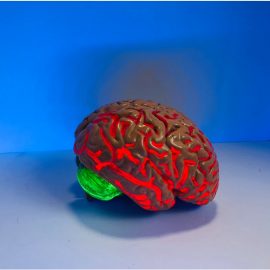

This article is an excerpt from the Shortform book guide to "Blue Mind" by Wallace J. Nichols. Shortform has the world's best summaries and analyses of books you should be reading.
Like this article? Sign up for a free trial here.
Why are humans so drawn to water? How do we benefit by looking at, being near, and being in water?
In Blue Mind, Wallace J. Nichols argues that water has a profound impact on our well-being and health because it induces a calming, meditative state he refers to as Blue Mind. He shares ways we can enjoy water’s benefits and discusses the challenges that some face in having access to water.
Continue reading for an overview of this book that will have you thinking about water in a new way.
Overview of Blue Mind by Wallace J. Nichols
In Blue Mind, Wallace J. Nichols explains that we’re naturally drawn to water because it’s critical to our survival, and he elaborates on the additional benefits water provides us with, including its capacity to reduce stress and stimulate our senses in an enjoyable way. He describes several ways people can interact with water to get its benefits, and he addresses the relationship between our society and water.
Nichols is a research associate at the California Academy of Sciences. He also co-founded and co-directs LiVBLUE, Ocean Revolution, and SEE the WILD.
We’ll explore why humans are so attracted to water and describe the ways it reduces stress and allows the mind to heal and rest. We’ll also discuss why it appeals to various senses, such as sight and hearing, and look at different ways of being in or around water. We’ll conclude by exploring society’s relationship with water and how it might be improved.
We’re Naturally Drawn to Water
According to Nichols, humans evolved to want to be near water because it’s necessary for our survival. Throughout history, we’ve naturally gravitated toward habitats that included water, such as lakes, rivers, and coasts. Water consumption is necessary for life, but there were other reasons humans as a whole were drawn to water, as well.
Experts suggest that water sources—along with open spaces with low grass and trees—make up part of a “universal landscape,” or a natural environment that has all the resources necessary to ensure humans’ survival. The accessible water source provides water for consumption as well as a source of marine food, the grass and trees offer food and room to attract and hunt prey, and the open spaces provide visual clearance to detect incoming predators. Forming communities near landscapes like this increased humans’ chances of survival, resulting in an evolutionary connection between humans and water.
The Meaning of “Blue Mind” and “Red Mind”
Nichols uses the term “Blue Mind” to describe water’s impact on the brain. Blue Mind is a calm, peaceful, contented state similar to one achieved through meditation, and it can be induced by proximity to water.
He distinguishes Blue Mind from “Red Mind,” which is a mental state characterized by stress and arousal, and he presents the Blue Mind state as a potent antidote to the detrimental effects of the Red Mind state. The stress response, also known as the fight or flight response, is an important evolutionary feature that developed to help us deal with danger. It enabled us to defend ourselves from threats or remove ourselves from threatening situations by flooding our bodies with stress hormones like norepinephrine, glucocorticoids, and cortisol. These hormones enhance our senses and awareness so we can better cope with danger.
The Effects of Ongoing Stress
However, this stress response also triggers when we’re facing non-life-threatening situations like the minor stresses we deal with every day as part of our normal lives. Regularly triggering the stress response can cause long-term damage to our health and well-being, especially when we experience stress that lasts three weeks or more. Such long-lasting stress can impair higher-level brain functions and make the brain’s fear and aggression structures overactive, which can impede judgment and cause depression and anxiety. It can also cause the hippocampus, the brain structure that creates new neurons (or brain cells) when the brain is learning, to atrophy, reducing cognitive ability.
According to Nichols, staying in the stress response state for too long also has ramifications on the body. It can cause reduced libido, autoimmune diseases, digestion issues, and musculoskeletal problems. All of these together lead to an increased risk of early death.
However, Red Mind is not all bad, explains Nichols. Extreme sports such as skydiving, rock climbing, and surfing can induce the stress response associated with Red Mind, and doing so in such a controlled, deliberate way can make it easier to manage the stress response from other aspects of life. Researchers suspect that this is because dealing with the stress response from these activities helps us learn how to put into perspective the stress we experience from less dangerous activities.
How Water Heals the Mind
Not everyone is able or willing to take part in extreme sports like skydiving to reduce their stress response, so Nichols suggests that engaging with nature, particularly water, can mitigate the stress response, as well. Extensive research using self-reported results, brain scans, and other tests shows that time spent in nature gives the brain a rest from stress, activating the parts of the brain that deal with empathy and pleasure, which calms the brain and nervous system.
You can achieve these effects not only by immersing yourself in nature through activities like fishing or snorkeling, but also by spending time in places like aquariums or near fountains, and even by looking at images of natural landscapes or listening to nature sounds.
Attention Fatigue: Water Lets the Mind Rest
Nichols argues that one of the ways water reduces the stress response is by allowing your mind to rest. When your mind is at rest, your emotions and empathy become more active, resulting in a relaxing, stress-reducing state.
Environmental psychologists Stephen and Rachel Kaplan established a theory of two different kinds of attention: directed and involuntary. Directed attention requires you to focus intently on something, which takes up a lot of mental energy. We use directed attention when we’re focusing on work, socializing, driving, or making decisions. Exercising directed attention nonstop for long periods eventually results in what the Kaplans call “directed-attention fatigue,” which reduces our mental capabilities.
Involuntary attention, on the other hand, is mostly effortless. We use it when we’re in situations that are different from our usual environments but familiar enough to be interesting without being threatening. When we pay attention to things in these situations, it’s usually only briefly and doesn’t require us to react much, and this gives our brains the chance to rest. Natural environments—particularly those that include water—promote involuntary attention.
Water and Creative Inspiration
Water also promotes creativity. Nichols suggests that shifting from directed attention to involuntary attention puts you into a state of mind that lets you create new, spontaneous ideas and engage in improvisational thinking. Nichols refers to this as a state of “flow.”
How Water Appeals to Our Senses
Water is enticing to us not only because it reduces stress and heals the mind but also because it has a powerful sensory appeal. This sensory appeal is part of what contributes to the Blue Mind effect.
Water’s Visual Appeal
As discussed above, Nichols explains that even looking at images of water can provide the positive psychological effects of the Blue Mind state. The color blue itself is calming to us. Psychological and marketing research shows that people associate the color blue with concepts like cleanliness, openness, strength, trust, and wisdom, and that blue is the most popular favorite color worldwide by a large margin.
Some experts theorize that people feel so positively toward the color blue because, between the blue sky and the blue water that covers most of our planet, we evolved surrounded largely by shades of this color, so we find it comforting on a biological level.
Water also appeals to our visual sense because of its shiny, reflective surface and the way it gently moves. Nichols explains that we’re naturally mesmerized by the simultaneously changing and repeating patterns we see on the surface of water and that watching these patterns engages our involuntary attention and calms and relaxes the mind.
Water’s Buoyant Appeal
The physical sensation of being in water is also very pleasing, writes Nichols. Because the human body is made up largely of water, and because the fat in our bodies and the air in our lungs are both lighter than water, we float, allowing us to enjoy a sense of weightlessness. Flotation—or the practice of floating motionless in water for extended periods—is often used to treat chronic pain, stress, injury, depression, and even conditions like ADHD and PTSD.
Water’s Auditory Appeal
According to Nichols, the sound of water also appeals to us for many reasons. One of these is that we first heard the sounds of water when we were floating in utero as fetuses, so those sounds are deeply comforting as they remind us of being in the womb.
Additionally, since the sounds of water tend to be gentle, regular, quiet, and mid-to-low frequency, they’re inherently pleasing to our ears. Conversely, we’re frequently exposed to sounds that are overly loud, harsh, high-pitched, or arrhythmic in our daily lives from sources such as traffic and machinery. Pleasant sounds like those from water—whether it’s the sound of ocean waves, a waterfall, or a babbling brook—can improve mood, relaxation, and concentration.
Ways to Enjoy the Water
There are many ways to enjoy the benefits of water. Nichols explains that it’s not just being in water that induces a Blue Mind state, but also being on the water, being near the water, or even looking at images of water. He describes several ways people interact with water to obtain its benefits.
Exercise: Swimming
Nichols explains that swimming is appealing because of the body’s buoyancy, which causes a 200-pound body to weigh only 10 pounds in the water. The water also provides resistance, so moving our bodies through it stretches and exercises all the body’s muscles while taking pressure off the joints and ligaments.
Additionally, the physical pressure of being immersed in water—known as hydrostatic pressure—can provide a full-body soothing sensation. This pressure also restricts circulation to the extremities, which causes the heart to work harder to pump blood throughout the entire body, resulting in greater blood flow. This makes the body’s arteries relax to reduce the resistance against the blood flow, and this arterial relaxation leads the body to activate the same neurotransmitters that activities like meditation activate. The lungs also have to work harder to function under the pressure of the water—and deal with the increased blood flow—and all of this together can greatly improve cardiovascular strength.
Swimming also provides aerobic exercise, which promotes the release of stress-relieving hormones and neurotransmitters like endorphins and endocannabinoids. This, combined with the rhythmic breathing required for swimming, produces a state similar to that induced by meditation.
Extreme Water Sports: Surfing and Diving
Another way of interacting with the water is through surfing. Nichols suggests that surfing is particularly conducive to the Blue Mind state because it requires surfers to be deeply attuned to the movement of the sea and monitor it very closely to see when they might be able to catch the perfect wave. Surfing also affects the brain in a similar way as do many addictive substances: When engaging in an activity that’s novel, risky, rewarding, and challenging, the brain produces a rush of dopamine that we can easily become dependent on. Both surfing and addictive drugs meet all these criteria. Because of this, Nichols often recommends surfing as a positive addiction that people can substitute for harmful addictions.
Diving is another popular water sport that Nichols discusses. Diving is particularly appealing to the senses because it involves looking at and touching things under the water—a very different experience from the things we’re able to look at and touch on land. Diving also magnifies the effects of hydrostatic pressure, which increases by one atmosphere every 10 meters below the surface. This comes with some risks, as being exposed to too much pressure can result in nitrogen narcosis (a state of euphoria or confusion from nitrogen entering the bloodstream), and coming up too quickly can result in the bends (or decompression sickness). However, diving is associated with greater adventurousness, less anxiety, and greater health overall.
Recreation: Fishing and Boating
Some people prefer to be near the water rather than in it or under it. Fishing is a great way to do that, explains Nichols. Fishing has been shown to calm the mind and reduce stress, and the physical motions involved in fishing provide effective therapies for many ailments. For example, the motions involved in fly-fishing help improve the strength and flexibility of chest muscles in people who’ve had breast cancer surgery. The focus and patience involved in fishing can also be good therapy for people with PTSD or other disorders. It’s also at a skill level that’s accessible to most people, which can make it a better option than more difficult activities like swimming or diving.
Boating and similar activities like kayaking also offer the benefits of being in proximity to water. Activities like rowing and paddling provide a great upper-body workout, and sailing boats that require the work of multiple people can improve confidence, teamwork, and social skills. The main appeal that Nichols hears from boaters is the sense of freedom it provides—being out in the open air, immersed in nature, away from the constricting demands of daily life.
Working: Sailing and Commercial Fishing
Some professions also require working on the water. Sailors and commercial fishers spend long stretches of time interacting with the water to earn a living and provide food and transportation. According to Nichols, these workers also cite the sense of freedom as a major reason they’re drawn to these professions, along with the pride they take in their work and the challenge of taking on the sea every day.
These challenges can sometimes be very dangerous. Due to the demands of keeping a ship operating for 24 hours a day, sailors are often sleep deprived, and they often deal with heavy machinery that can cause severe injury. Overfishing can also deplete fish populations and has led to government bans on fishing in some areas, decreasing the availability of such jobs and making them a less viable option for earning a living.
Society’s Relationship With Water
While the benefits of water are many, there are some societal obstacles to accessing them, including financial issues and environmental damage. The Blue Mind state is not as easy to attain for some people as it is for others.
The Cost of Water-Adjacent Properties
Nichols explains that real estate that’s near water is in extremely high demand. As a result, these properties are much more expensive than similar properties—or even higher quality properties—away from the water. People with the means to do so will often pay millions of dollars for even the shabbiest homes if they’re next to a water source. Nichols cites this as evidence of how highly we value water. However, because man-made water features also provide the benefits of Blue Mind, you don’t necessarily need to live right by the ocean, a lake, or a river to enjoy the effects of water.
The Environmental Movement: Using Love to Inspire Action
Nichols argues that the methods we use to encourage environmental activism are misguided and that we should instead tap into our inherent appreciation for the planet to better motivate people to take action. He suggests that approaching these efforts with an attitude that places blame on people for their inaction, or that overwhelms them with depressing facts and statistics, is unproductive. These approaches make people feel ashamed and afraid, often causing them to tune out or resist the message.
Nichols recommends encouraging people to take on a biocentric view of the natural world—one that regards our relationship with nature as a partnership and takes into account not only how nature affects humans but also how humans affect nature. He explains that a biocentric view is one built on love and that taking on this type of worldview would prompt people to work harder to protect our natural environment.
He suggests that the way to shift our collective view of nature to a biocentric one is to tap into people’s natural emotions and the connection we feel to nature and that the best way to do this is to first establish the human connection with nature. For example, people will likely be more receptive to the idea of taking action on climate change after walking through an aquarium, and they’ll respond better to an image of a damaged environment if they first see images of that environment in its unspoiled state.

———End of Preview———
Like what you just read? Read the rest of the world's best book summary and analysis of Wallace J. Nichols's "Blue Mind" at Shortform.
Here's what you'll find in our full Blue Mind summary:
- How water has a profound impact on our well-being and health
- Society’s relationship with water and how it might be improved
- Activities you can do in or around water to reap the healing benefits






